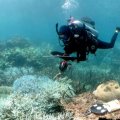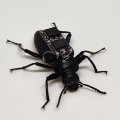University of Queensland researchers and graduates are playing an important role in the design of the Sydney Olympic venues, reflecting well on the quality of Queensland architectural design.
Head of the University's Architecture Department Michael Keniger said it was encouraging that the University had direct involvement in the standards and qualities of such major architectural projects in Australia.
The Sydney 2000 Olympics site at Homebush Bay would set a 'new standard' in urban environmental planning and design, he said.
Mr Keniger is the interstate member of the Olympic design review panel chaired by NSW Government architect Chris Johnson and reporting directly to the director-general of the Olympic Co-ordinating Authority David Richmond.
The panel reviews all design proposals for major buildings, public spaces and public facilities at Olympic venues.
'It has been successful in co-ordinating designs for many different buildings, guiding key ideas for public spaces between buildings and raising awareness for the need for good design,' Mr Keniger said.
'Some people may see us as ?style police' but we see our role as providing support for good design. Each project manager has been convinced of the importance of releasing some budget to pay for the linking spaces between buildings.'
Mr Keniger said the Sydney Olympics would be a once-in-a-lifetime opportunity to showcase good design in major public buildings and raise public expectations for quality design.
'The Games must open on time, and they must be good. And the site must work, both in Olympic and non-Olympic modes,' he said.
Australia had some 'woeful' public buildings so it was important that only good design was showcased at the Olympic site.
He said the University of Queensland was well represented in architectural designs for the Olympic site.
University of Queensland graduate Graham Bligh of Bligh Lobb architects has designed the $665 million main Olympic stadium at Homebush, due for completion next year. The stadium, designed around an oval athletics track and a north-south field, will have games seating of 110,000, reducing to 80,000 afterwards.
University of Queensland architecture graduates Annabel Latz and Andrew Nimmo have been commissioned to undertake a special overlay of the Olympic site to help the public around the area at the opening of the Royal Easter Show in April.
The Sydney Royal Easter Show this year will move from Paddington to Homebush, raising people's understanding of the Olympic site and potentially ironing out teething problems.
'For many the show will be a first exposure to the Homebush Bay developments, and so the built environment will strongly influence perceptions of progress towards the Olympics,' Mr Keniger said.
Mr Keniger is also a member of the reference panel reviewing the need for shade and shelter provision for the Olympics and will guide the evolution of appropriate shade creation strategies.
With senior lecturer in the University's Architecture Department Brit Andresen, he recently co-ordinated research and a training program for Queensland's first shade guidelines for young children, public pools and sporting fields.
Funded by a Queensland Health grant, the three guideline books, Shade for Sports Fields, Shade for Public Pools and Shade for Young Children, were published and launched between 1995 and 1997. Also funded by Queensland Health, the training program, based on the three books, is due for completion by the middle of the year.
Mr Keniger chairs the design review panel for the South Bank Corporation. That panel has guided a new master plan for the $80 million completion of South Bank and advises on design standards, using the same model as the Olympics, incorporating peer review.
He has assisted the Department of Communication and the Arts on selecting designs for the new National Museum at Acton Peninsula, Canberra, on the site of the old Canberra Hospital.
After advising the government on the running of a competition and selection of architects for the project, he has now been invited to maintain a watching brief on the design's development.
Mr Keniger is a former president of the Queensland chapter of the Royal Australian Insitute of Architects and a former chair of the Committee of Heads of the Architectural Schools of Australia (CHASA).
For further information, contact Mr Keniger, telephone 07 3365 3843.
.jpg)


